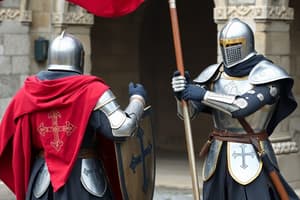Podcast
Questions and Answers
What emphasized honor, loyalty, and bravery in medieval times?
What emphasized honor, loyalty, and bravery in medieval times?
- Origins of Knighthood
- Chivalric Virtues
- Code of Chivalry (correct)
- Orders of Chivalry
What type of warfare involved surprise attacks on enemy territories?
What type of warfare involved surprise attacks on enemy territories?
- Cavalry Charges
- Sieges
- Battles
- Raids (correct)
What type of soldiers fought on horseback in medieval warfare?
What type of soldiers fought on horseback in medieval warfare?
- Archers
- Men-at-Arms
- Knights (correct)
- Soldiers
What was the primary focus of the Chivalric Virtues?
What was the primary focus of the Chivalric Virtues?
What was the purpose of Orders of Chivalry?
What was the purpose of Orders of Chivalry?
What type of castles were built on raised earth mounds?
What type of castles were built on raised earth mounds?
What was the purpose of siege engines in medieval warfare?
What was the purpose of siege engines in medieval warfare?
What was the primary role of archers in medieval warfare?
What was the primary role of archers in medieval warfare?
What was the primary component of a Motte-and-Bailey Castle?
What was the primary component of a Motte-and-Bailey Castle?
Flashcards are hidden until you start studying
Study Notes
Chivalry and Knighthood
- Code of Chivalry: a set of rules and ideals that knights were expected to follow, emphasizing honor, loyalty, and bravery
- Origins of Knighthood: originated in the 9th century as a class of mounted warriors, evolved into a noble class by the 12th century
- Training and Education: knights trained from a young age in martial skills, literature, and etiquette
- Chivalric Virtues: courage, honor, loyalty, and courtesy were considered essential qualities for a knight
- Orders of Chivalry: fraternal organizations that promoted the ideals of chivalry, such as the Order of the Garter and the Order of the Temple
Medieval Warfare
- Types of Warfare:
- Battles: pitched battles between armies
- Sieges: attacks on fortified positions, such as castles
- Raids: surprise attacks on enemy territories
- Armies and Soldiers:
- Knights: heavily armored cavalry, considered the elite of medieval warfare
- Men-at-Arms: infantry soldiers who fought on foot
- Archers: specialized troops who used bows and arrows
- Castles and Fortifications:
- Motte-and-Bailey Castles: early castles built on raised earth mounds
- Stone Castles: later castles built with stone walls and towers
- Moats: water-filled ditches surrounding castles for defense
- Warfare Tactics:
- Cavalry Charges: knights would charge enemy lines on horseback
- Archery Duels: archers would engage enemy archers in a duel
- Siege Engines: catapults, trebuchets, and other machines used to breach castle walls
Chivalry and Knighthood
- The Code of Chivalry was a set of rules and ideals that emphasized honor, loyalty, and bravery, and was expected to be followed by knights
- Knighthood originated in the 9th century as a class of mounted warriors, evolving into a noble class by the 12th century
- Knights trained from a young age in martial skills, literature, and etiquette, and were required to possess essential qualities such as courage, honor, loyalty, and courtesy
- Orders of Chivalry, such as the Order of the Garter and the Order of the Temple, were fraternal organizations that promoted the ideals of chivalry
Medieval Warfare
- Medieval warfare involved three types of warfare: battles, sieges, and raids
- Armies consisted of knights, men-at-arms, and archers, with knights being heavily armored cavalry and men-at-arms being infantry soldiers who fought on foot
- Castles and fortifications included motte-and-bailey castles, stone castles, and moats, with the latter being water-filled ditches surrounding castles for defense
- Warfare tactics included cavalry charges, archery duels, and the use of siege engines such as catapults and trebuchets to breach castle walls
Studying That Suits You
Use AI to generate personalized quizzes and flashcards to suit your learning preferences.




